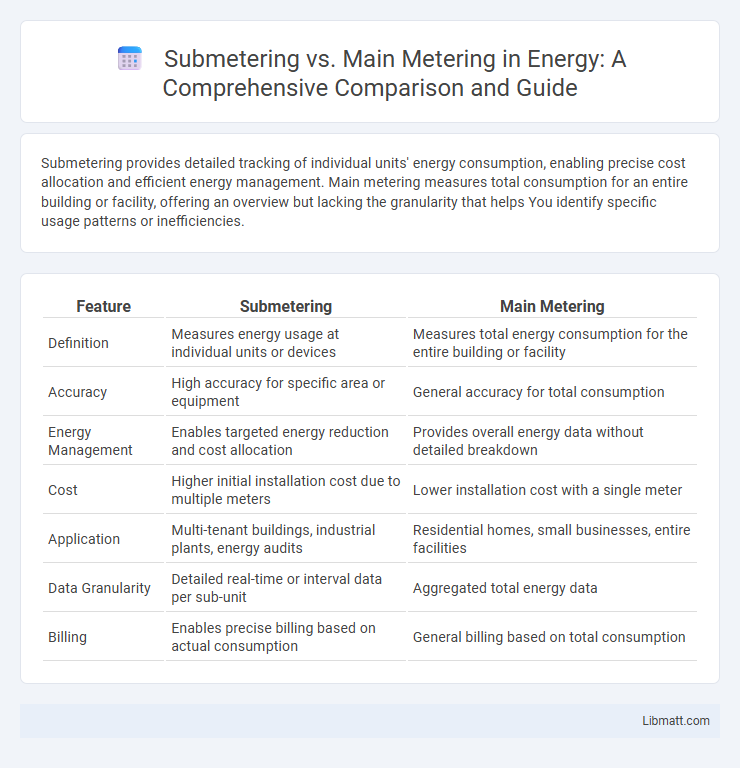Submetering provides detailed tracking of individual units' energy consumption, enabling precise cost allocation and efficient energy management. Main metering measures total consumption for an entire building or facility, offering an overview but lacking the granularity that helps You identify specific usage patterns or inefficiencies.
Table of Comparison
| Feature | Submetering | Main Metering |
|---|---|---|
| Definition | Measures energy usage at individual units or devices | Measures total energy consumption for the entire building or facility |
| Accuracy | High accuracy for specific area or equipment | General accuracy for total consumption |
| Energy Management | Enables targeted energy reduction and cost allocation | Provides overall energy data without detailed breakdown |
| Cost | Higher initial installation cost due to multiple meters | Lower installation cost with a single meter |
| Application | Multi-tenant buildings, industrial plants, energy audits | Residential homes, small businesses, entire facilities |
| Data Granularity | Detailed real-time or interval data per sub-unit | Aggregated total energy data |
| Billing | Enables precise billing based on actual consumption | General billing based on total consumption |
Introduction to Submetering and Main Metering
Submetering involves installing additional meters to measure energy consumption for individual units or specific areas within a larger building, enabling precise tracking and cost allocation. Main metering, by contrast, records the total energy usage of an entire property through a single meter, providing an overall consumption overview. Understanding these systems helps you optimize energy management and billing accuracy in multi-tenant or multi-use facilities.
Definitions: Submetering vs Main Metering
Submetering involves installing individual meters within a building or property to measure energy or water usage for specific units or areas, enabling precise consumption tracking and billing. Main metering refers to a single, central meter that records the total utility consumption for an entire building or facility without breakdown by individual units. Submetering provides detailed data for targeted energy management, whereas main metering offers an aggregate consumption overview.
Key Differences Between Submetering and Main Metering
Submetering involves installing meters at individual units or specific areas to accurately track energy or water consumption separately from the main supply, enabling precise billing and usage monitoring. Main metering measures the total consumption for an entire building or complex, providing a consolidated data point without detailing individual usage patterns. Understanding the key differences between submetering and main metering helps you optimize resource management, identify inefficiencies, and implement fair billing practices tailored to each unit.
Advantages of Submetering
Submetering provides precise utility consumption data for individual units, enabling fair billing and encouraging energy conservation. It reduces disputes between landlords and tenants by attributing costs accurately, enhancing transparency and accountability. This system also supports easier identification of leaks or inefficiencies, leading to improved maintenance and cost savings.
Benefits of Main Metering
Main metering provides a comprehensive overview of total energy consumption, enabling more accurate billing and efficient demand management. It simplifies system maintenance by consolidating data from multiple sources into a single point of measurement, helping to identify peak usage periods and optimize load distribution. Your facility benefits from cost savings and streamlined operations due to the centralized monitoring and reduced infrastructure complexity offered by main metering.
Applications and Use Cases
Submetering provides detailed energy consumption data for individual tenants, departments, or specific equipment, enabling precise cost allocation and targeted energy management in commercial buildings, multi-family residential complexes, and industrial facilities. Main metering captures overall facility consumption, essential for utility billing and high-level energy monitoring. Submetering supports demand response programs, tenant billing, and energy efficiency initiatives, while main metering helps track total usage for regulatory compliance and peak demand management.
Cost Implications and ROI
Submetering offers more precise allocation of utility costs, enabling building owners to identify usage patterns and control expenses effectively, which can lead to significant long-term savings. Main metering consolidates charges but often masks individual unit consumption, potentially resulting in higher overall costs and less transparent billing. Investing in submetering improves your ROI by promoting energy efficiency, reducing disputes, and encouraging responsible consumption among tenants.
Data Accuracy and Energy Monitoring
Submetering provides enhanced data accuracy by measuring energy usage at individual points or units, allowing precise tracking of consumption patterns and identifying inefficiencies. Main metering offers a broader overview of total energy use but lacks the granularity needed for detailed analysis or pinpointing specific issues. Your energy monitoring becomes more effective with submetering, as it delivers actionable insights for optimizing consumption and reducing costs at a micro-level.
Scalability and Flexibility
Submetering offers superior scalability and flexibility by allowing individual monitoring of energy consumption across multiple tenants or zones, enabling tailored billing and usage analysis. Main metering aggregates overall energy use at the building level, limiting granularity and customization but providing simpler installation and maintenance. As buildings expand or tenant configurations change, submetering systems can be easily adjusted or expanded, unlike main metering which generally requires extensive infrastructure modification to scale effectively.
Choosing the Right Solution for Your Needs
Selecting between submetering and main metering depends on your specific energy management goals and building type. Submetering provides detailed consumption data for individual tenants or units, enabling precise billing and targeted energy savings, while main metering offers a comprehensive overview of total building usage with simpler installation. You should evaluate factors like budget, desired accuracy, and operational complexity to determine the most effective metering system for your property.
Submetering vs Main Metering Infographic

 libmatt.com
libmatt.com